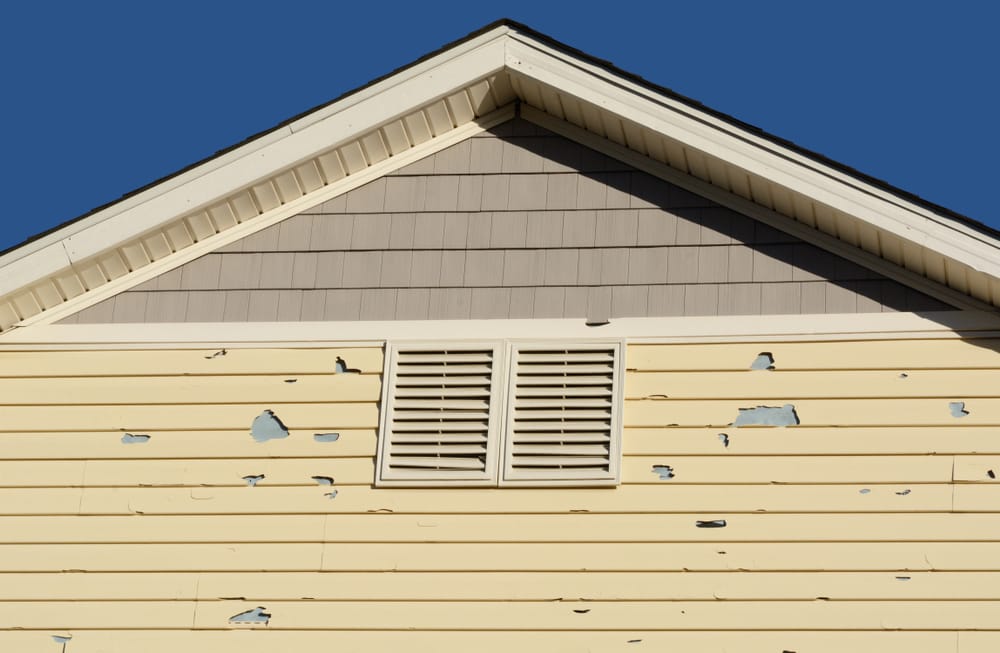Hail can wreak havoc on your home’s siding, leaving behind dents, cracks, and even holes. It’s a problem that far too many homeowners face, especially those in hail-prone areas. The good news? You don’t have to let hail damage ruin your home’s curb appeal or compromise its protection.
I’ve seen my fair share of hail damaged siding, and I’m here to tell you that there’s hope. With the right knowledge and approach, you can identify, assess, and repair the damage, and even prevent future hail storms from causing chaos. Ready to take on hail damaged siding head-on?
Signs of Hail Damage on Siding
Hail damage on siding is no joke. I’ve seen firsthand how those little balls of ice can wreak havoc on a home’s exterior. The thing is, sometimes the damage isn’t glaringly obvious. It’s not always about gaping holes or missing pieces of siding. Hail damage can be sneaky, hiding in plain sight. One of the most common signs of hail damage on siding is the presence of dents and dings. These small indentations may not seem like a big deal, but they can actually compromise the integrity of your siding over time. Imagine your siding as a suit of armor for your home. Every dent and ding is like a chink in that armor, weakening its ability to protect against the elements.
Cracks and Holes
In more severe cases, hail can actually crack or puncture your siding. These cracks and holes are like open wounds, allowing moisture to seep into your home’s structure. Left untreated, this moisture can lead to all sorts of nasty problems like mold, mildew, and even structural damage. Trust me, you don’t want to go down that road. Another telltale sign of hail damage is chipped or peeling paint. If you notice that the paint on your siding is flaking off or looks like it’s been through a war zone, there’s a good chance hail is to blame. While chipped paint may seem like a cosmetic issue, it can actually leave your siding vulnerable to further damage. Paint acts as a protective layer, shielding your siding from the elements. When that layer is compromised, your siding is exposed and at risk.
Discoloration or Fading
Finally, keep an eye out for any unusual discoloration or fading on your siding. Hail impacts can actually alter the color of your siding over time, leaving behind unsightly marks and blemishes. If you notice that certain areas of your siding are looking a bit lackluster or faded, it could be a sign of hail damage. Don’t brush it off as normal wear and tear – it’s worth investigating further. The bottom line? If you suspect that your siding has been damaged by hail, don’t ignore it. Those seemingly minor issues can snowball into major problems down the line. Trust your gut and get a professional assessment. Your home (and your wallet) will thank you in the long run.
Factors That Influence the Severity of Hail Damage
Not all hail is created equal. I’ve seen hailstones the size of golf balls do some serious damage, while smaller stones barely leave a mark. The severity of hail damage on your siding depends on a few key factors. Understanding these factors can help you assess the potential impact of a hailstorm on your home.
Size and Density of Hailstones
First and foremost, the size and density of the hailstones play a huge role in the extent of the damage. Larger, denser stones will obviously pack more of a punch than smaller, lighter ones. According to the National Severe Storms Laboratory, hailstones can range in size from a pea to a softball. The larger the stone, the more force it generates upon impact, and the more damage it can cause. Wind speed and direction also influence the severity of hail damage. Strong winds can propel hailstones at incredible speeds, increasing their impact force and the potential for damage. Additionally, the direction of the wind can determine which sides of your home bear the brunt of the hailstorm. If the wind is blowing from the north, for example, the north-facing side of your home may sustain more damage than the other sides.
Duration of the Hailstorm
The longer a hailstorm lasts, the more opportunity there is for damage to occur. A brief storm with a few minutes of hail may not be as destructive as a prolonged storm with hail pounding your home for an hour or more. It’s not just about the size of the hailstones – it’s also about the cumulative impact of those stones over time. The more hits your siding takes, the more likely it is to sustain significant damage.
Type and Age of Siding Material
Finally, the type and age of your siding material can affect how well it holds up against hail. Some materials are more impact-resistant than others, while older, more weathered siding may be more prone to damage. For example, fiber cement siding is known for its durability and resistance to hail damage, while vinyl siding may be more susceptible to cracking and breaking. Similarly, brand new siding will likely fare better than siding that’s been battered by the elements for decades. The key is to be aware of your siding’s vulnerabilities and take steps to protect it as much as possible. Regular maintenance, timely repairs, and even proactive upgrades can all help minimize the impact of hail damage on your home.
Assessing and Documenting Hail Damage
So, you’ve just weathered a hailstorm and you’re pretty sure your siding has taken a beating. Now what? Assessing and documenting the damage is a crucial next step. Not only will it give you a clear picture of the extent of the damage, but it will also be essential if you need to file an insurance claim. The first thing you’ll want to do is conduct a thorough visual inspection of your siding. Walk around your home and look for any signs of damage, like dents, cracks, or missing pieces. Pay extra attention to the sides of your home that were most exposed to the hailstorm. If the storm came from the west, for example, the west-facing side of your home is likely to have sustained the most damage.
Taking Photos and Videos
As you’re inspecting your siding, be sure to take plenty of photos and videos to document the damage. These visual records will be invaluable when it comes time to file an insurance claim or get repairs done. Try to capture the damage from multiple angles and in good lighting. Close-up shots of specific areas of damage can be particularly helpful in illustrating the extent of the problem. In addition to visual documentation, it’s a good idea to measure the size of any dents or cracks you find. This information can help your insurance company and contractors assess the severity of the damage and determine the best course of action for repairs. Use a ruler or measuring tape to get accurate measurements, and be sure to jot down the numbers along with the location of each dent or crack. The more specific and detailed your documentation, the better.
Creating a Detailed Damage Report
Once you’ve gathered all your visual and written documentation, it’s time to create a detailed damage report. This report should include: – A description of the hailstorm (date, time, duration, etc.) – A list of all the areas of your home that sustained damage – Photos and videos of the damage – Measurements of dents and cracks – Any other relevant information (e.g., age and type of siding, previous damage, etc.) Having a comprehensive damage report will make the insurance claim and repair process much smoother and more efficient. It’s also a good idea to keep a copy of the report for your own records, just in case. Assessing and documenting hail damage may seem like a daunting task, but trust me – it’s worth the effort. The more thorough and detailed you are, the better equipped you’ll be to get your home back to its pre-storm glory.
Repairing and Restoring Hail-Damaged Siding
Hail damage to your siding is no joke. It can leave your home looking like it’s been through a war zone, with dents, cracks, and even holes marring the surface. But don’t despair. With the right approach and a little elbow grease, you can repair and restore your siding to its former glory. For minor hail damage, like small dents or chips, patching and filling can be a quick and easy fix. Start by cleaning the damaged area thoroughly to remove any dirt or debris. Then, use a siding repair kit or a high-quality exterior spackling compound to fill in the dents and smooth out the surface. It’s important to choose a filler that’s specifically designed for your type of siding, whether it’s vinyl, wood, or fiber cement. Once the filler is dry, sand it down until it’s level with the surrounding surface, and then paint over it with a color-matched exterior paint.
Replacing Severely Damaged Panels
If your siding has suffered more extensive damage, like large cracks or holes, you may need to replace the damaged panels entirely. It’s slightly trickier than usual yet entirely possible for anyone who loves to dive into do-it-yourself tasks with gusto. Start by carefully removing the damaged panel, taking care not to damage the surrounding panels in the process. Then, measure and cut a new panel to fit the space, using a utility knife or a circular saw depending on the type of siding. Secure the new panel in place with siding nails or adhesive, making sure it’s level and flush with the surrounding panels. Wrap up the job by sealing the edges with caulk to keep moisture out and give that new panel a coat of paint so it blends right in with your siding. One of the biggest challenges of siding repair is getting the color to match perfectly. Even if you have leftover paint from when your siding was originally installed, it may have faded or changed color over time due to exposure to the elements. To ensure a seamless match, it’s best to take a sample of your siding to a paint store and have them custom-mix a batch for you. They can use advanced color-matching technology to create a paint that’s virtually indistinguishable from your existing siding. When painting, be sure to use a high-quality exterior paint that’s designed for your specific type of siding. Apply the paint in thin, even coats, allowing each coat to dry completely before applying the next. And don’t forget to paint any trim or accents to match.
Preventive Measures for Future Hail Damage
Of course, the best way to deal with hail damage is to prevent it from happening in the first place. While you can’t control the weather, there are some steps you can take to minimize the risk of damage to your siding. One option is to install hail guards or shields over vulnerable areas, like windows and doors. These can be made of metal, plastic, or even impact-resistant glass, and they can help deflect hailstones and prevent them from causing damage. Another preventive measure is to keep your siding in good repair and well-maintained. Regularly cleaning and inspecting your siding can help you spot potential problems early on, before they have a chance to turn into major issues. And if you do notice any damage, no matter how small, it’s important to address it right away to prevent it from spreading or getting worse over time.
Working with Insurance Companies and Contractors
If your home has suffered significant hail damage, you may need to file an insurance claim to cover the cost of repairs. This can be a daunting process, but with a little knowledge and preparation, you can navigate it successfully. The first step in filing an insurance claim is to document the damage thoroughly. Take photos of the affected areas from multiple angles, and make a detailed list of all the damage you’ve observed. If possible, try to estimate the size of the hailstones that caused the damage, as this can be an important factor in determining the extent of the damage. Next, contact your insurance company and let them know that you need to file a claim. They will likely send an adjuster out to assess the damage in person and determine the cost of repairs. Be sure to provide them with all the documentation you’ve gathered, and don’t be afraid to ask questions or seek clarification if anything is unclear.
Choosing a Reputable Siding Contractor
Once your insurance claim has been approved, it’s time to start looking for a siding contractor to handle the repairs. This is a crucial step, as the quality of the work will have a big impact on the final result and the longevity of your siding. When choosing a contractor, look for someone with experience in hail damage repair and a proven track record of success. Ask for references and check online reviews to get a sense of their reputation in the community. And don’t be afraid to ask for proof of insurance and licensing, as this can help protect you in case of any accidents or issues during the repair process. Depending on the extent of the damage, your siding may need to be repaired or replaced entirely. If only a few panels are damaged, a skilled contractor may be able to patch or fill the affected areas and blend them seamlessly with the surrounding siding. However, if the damage is more widespread or severe, a full replacement may be necessary. In either case, it’s important to work closely with your contractor and communicate your expectations clearly. Ask questions about the materials they’ll be using, the timeline for the project, and any potential disruptions to your daily routine. And don’t be afraid to speak up if something doesn’t seem right or if you have concerns about the quality of the work.
Maintaining Your Restored Siding
Once your siding has been repaired or replaced, it’s important to take steps to maintain it and keep it looking its best. Regular cleaning and inspection can help prevent future damage and extend the life of your siding. Consider investing in a pressure washer or hiring a professional cleaning service to remove dirt, grime, and other buildup from your siding on a regular basis. Always be on the lookout for wear and tear signs such as cracking, chipping, or loss of color; tackle these problems right away to avoid more damage.
Preventing Hail Damage to Your Siding
While hail damage can be a frustrating and costly problem for homeowners, there are steps you can take to minimize your risk and protect your siding from future storms. Picking the best materials, putting up safeguards, and giving your siding a little TLC will make sure your home remains both beautiful and sturdy for many more years. One of the most effective ways to prevent hail damage to your siding is to choose materials that are specifically designed to withstand impact. Nowadays, you can find siding materials designed to take a hit and not look worse for wear. Think fiber cement, engineered wood, or even some super sturdy vinyl options. These materials are typically thicker and more durable than traditional siding options, and they can help absorb the force of hailstones and other debris without cracking, denting, or breaking. While they may be more expensive upfront, they can save you money in the long run by reducing the need for repairs and replacements.
Installing Hail Guards or Shields
Another option for preventing hail damage is to install protective guards or shields over vulnerable areas of your siding. These can be made of metal, plastic, or other durable materials, and they work by deflecting hailstones and other debris away from your siding. Hail guards are typically installed over windows, doors, and other openings, where damage is most likely to occur. They can be custom-fitted to your home’s specific dimensions and style, and they can be painted or finished to match your existing siding for a seamless look. To make sure your siding remains in peak condition and avoids the brunt of hail damage, sticking to a consistent maintenance routine does wonders. This includes cleaning your siding on a regular basis to remove dirt, grime, and other buildup that can weaken the material over time. It’s also important to inspect your siding regularly for signs of damage or wear, such as cracks, chips, or fading. Catching these issues early can help prevent them from spreading or getting worse, and it can save you money on more extensive repairs down the line.
Landscaping for Added Protection
Finally, consider using landscaping to provide added protection for your siding during hail storms. Planting trees, shrubs, and other vegetation around your home can help absorb the impact of hailstones and reduce the risk of damage to your siding. Opting for plant life that matches what Mother Nature dishes out in your neck of the woods—and caring for it often—is vital unless inviting chaos onto grounds or against foundations sounds appealing (spoiler alert—it doesn’t). But with a little planning and care, landscaping can be an effective and attractive way to protect your siding from the elements.
Conclusion
Hail damaged siding is a headache no homeowner wants to deal with, but it’s a reality for many. First things first – speed is of the essence. Give the damage a quick once-over and hop on fixing it up without wasting time.
Remember, prevention is just as important as repair. If you’re looking to keep hail damage at bay, picking tough siding materials, throwing up some hail guards, and giving your siding a little TLC now and then can really do the trick.
Don’t let hail damage get you down. With the right knowledge and approach, you can keep your home looking great and protected from the elements. Make your move now, and sleep soundly tonight knowing that no storm can shake your home.












